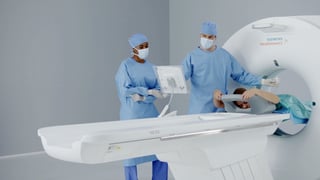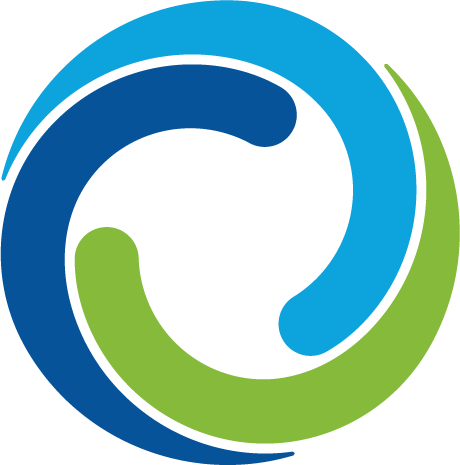
At the 103rd Scientific Assembly and Annual Meeting of the Radiological Society of North America (RSNA), Nov. 26 to Dec. 1 at Chicago’s McCormick Place, Siemens Healthineers presented its new computed tomography (CT) scanner portfolio, which covers all major requirements and customer needs regarding CT imaging.
With their innovative workflow technologies, the portfolio’s four new CT scanners help deliver a new level of standardized, high-quality examinations that support clinical users on their way to precision medicine, while potentially improving patient satisfaction.
The two new scanners in the SOMATOM go. platform – SOMATOM go.All and SOMATOM go.Top – expand the mobile workflow into advanced clinical fields such as cardiology and CT-guided intervention. This mobile workflow enables the technologist to remain closer to the patient during exam preparation and the actual scan.
With its high-end systems for single- and dual-source imaging – SOMATOM Edge Plus, SOMATOM Drive, and SOMATOM Force – Siemens Healthineers is introducing to the CT market the new, innovative FAST (Fully Assisting Scanner Technologies) Integrated Workflow with the brand-new FAST 3D Camera.¹ Using artificial intelligence and deep learning technology, the camera automatically facilitates precise, consistent isocentric positioning of patients. By enabling the potential for fewer rescans, the potential for lower costs may be realized.
“We believe that our new scanner portfolio is the best possible answer to the very different challenges in computed tomography – in particular, to the simultaneous issues of growing patient numbers and declining reimbursement rates,” said André Hartung, Head of Computed Tomography at Siemens Healthineers. “With our innovative technologies, we can contribute to the success of healthcare providers by helping them tap the full potential of CT and to offer high-quality examinations while also reducing costs.”
Mobile workflow now in cardiology
With its new models SOMATOM go.All and SOMATOM go.Top, Siemens Healthineers further strengthens its SOMATOM go. platform and expands the range of clinical applications for its patient-centric mobile workflow operated via tablet and remote. With a 0.33 second rotation time and the established Stellar detector technology, the 64-slice SOMATOM go.All can cover scan ranges of up to 100 mm in one second. The 128-slice SOMATOM go.Top can perform whole-body scans of up to 200 cm with a scan speed of up to 175 mm per second. This means that users can deploy the SOMATOM go. platform’s mobile workflow in advanced clinical fields such as emergency medicine, interventional radiology (steered by Guide&GO, the first tablet-based solution for CT-guided interventions), and even cardiology, which is a major growth area for many healthcare providers because of the sharp rise in coronary CT angiography.
The new X-ray tube allows users to adjust the tube voltage in 10-kilovolt increments while keeping the tube current high. In this way, users can adapt the settings to each patient’s individual anatomy. Examinations performed at just 70 kv with a current of up to 825 milliamps, for instance, can significantly reduce X-ray dose and the amount of contrast. SOMATOM go.Top also offers TwinBeam Dual Energy imaging, which enables users to examine the same body region at two different energy levels simultaneously. The technology splits the X-ray beam into two energy spectra before it reaches the patient. With a scan mode that is not different from a routine CT examination, TwinBeam Dual Energy can therefore acquire two image datasets that provide additional information about the tissue, which is particularly beneficial in soft tissue differentiation and for oncology.
In all applications, patients benefit from a comfortable examination situation: All scanners in the SOMATOM go. platform (including the two new additions) are operated via a tablet and remote that can be used to control all routine and advanced examinations. Technologists can remain close to patients during the entire scan preparation process, which can make the experience more pleasant for patients, particularly children.
Additional innovative hardware designs have been introduced with the SOMATOM go. platform. Following integration of all computer hardware into the gantry, a new injector arm is now available. This smart, ergonomic solution allows the user to swivel the tablet and the injector around the gantry.
Innovations for precision medicine
In the high-end segment, Siemens Healthineers introduces two new flagship products in its portfolio: SOMATOM Edge Plus, the new premium single-source system, and SOMATOM Force, the new version of the leading system in the dual-source field (i.e., systems equipped with two X-ray tubes and two detectors). The new systems allow clinical users to cover all CT applications, regardless of patient or clinical issue. Both systems also offer high-precision diagnostics, which is a prerequisite for individualized prevention and therapy. “More than 200 scientific papers show what SOMATOM Force is capable of,” said André Hartung. “With this new version of our top-of-the-range system, we want to help our customers take the next step on their way to precision medicine.”
Such precise diagnostics come from the FAST applications that are integrated into the premium systems. One application is the FAST Integrated Workflow with the all-new FAST 3D Camera for automatic patient positioning. In many CT examinations, incorrect patient positioning is an obstacle to achieving optimal results. This new innovation is designed to help users eliminate position misalignment, which studies show can average around 2.6 cm from true isocenter.² This misalignment positioning results in more image noise or – to counteract the noise – increased dose levels.
In SOMATOM Edge Plus and the Dual Source scanners SOMATOM Drive and SOMATOM Force, a 3D camera is fitted above the patient table that uses artificial intelligence and deep learning technologies to recognize patient anatomical landmarks. This technology enables institutions to potentially have fewer rescans, decrease the time required for patients and staff, and therefore benefit from precise diagnostics at lower cost. The two touch-operated control panels fitted directly on the scanner allow radiology staff to remain close to the patient during most of the time needed for scan preparation.
The new single-source SOMATOM Edge Plus system combines the Straton MX Sigma X-ray tube, high power reserves at every kV value in 10-kV steps, and the Stellar Infinity detector. This provides the powerful imaging chain for scanning obese patients with diagnostic confidence – enabling sharp, rich-in-contrast images at high speed and low dose. In addition, the scanner is equipped with TwinBeam Dual Energy scan modes and the Tin Filter technology that facilitates CT scans at very low doses by shielding patients from clinically irrelevant radiation. Tin Filter technology can be used in all routine examinations and allows users to perform CT imaging at very low dose values which, in the case of lung cancer screening, for instance, do not exceed those of a normal X-ray examination. With the introduction of the new scanners, Tin Filter technology is now available across the complete Siemens Healthineers CT portfolio.
The new version of the SOMATOM Force system delivers – as evidenced in its initial model – impressive results, particularly in highly challenging situations. One example is functional imaging. Although functional imaging provides additional image information, the high levels of radiation involved mean that it has yet to become routine in many applications. SOMATOM Force allows functional imaging to become part of clinical practice because it offers a perfusion range of up to 22 cm that can cover entire organs. Its Vectron X-ray tubes, with a power-independent focal spot size of just 0.4 × 0.5 mm (IEC) and the highly sensitive Stellar Infinity detector, make SOMATOM Force the ideal scanner when high-speed (up to 737 mm/s), large-volume coverage combined with outstanding image quality is required. Furthermore, the scanner offers precise and dose-neutral quantification with the best spectral separation in Dual Energy acquisition to generate high-quality diagnostic results.
SOMATOM Force and SOMATOM Drive, which make up the company’s dual source family of CT systems, also set new standards in image quality and ease of Dual Energy workflows. Rapid Results Technology allows the dual-source scanner to communicate directly with syngo.via for zero-click postprocessing. As a result, large Dual Energy CT datasets are sent automatically to the picture archiving and communications system (PACS). This task is now part of standard reconstructions, enabling standardized and consistent image quality independent of operator skills.
Customers with existing SOMATOM Force and SOMATOM Drive CT systems will have the option of retrofitting their systems with the new FAST 3D Camera.
1 510(k)-pending
² Li, J., Udayasankar, U.K., Toth, T.L., et al. (2007). Automatic patient centering for MDCT: effect on radiation dose. AJR, 188: 547-52. Also, Kaasalainen, T., Palmu, K., Lampinen, A., et al. (2013). Effect of vertical positioning on organ dose, image noise and contrast in pediatric chest CT-phantom study. Pediatric Radiology, 43: 673-84.
The products/features (here mentioned) are 510(k)-pending and not commercially available in all countries. Due to regulatory reasons their future availability cannot be guaranteed. Further details are available from the local Siemens organizations.
Siemens contact for journalists: Jeff Bell, Siemens Healthineers; Phone: 484-868-8346; E-mail: jeffrey.t.bell@siemens-healthineers.com
Siemens Healthineers is the separately managed healthcare business of Siemens AG enabling healthcare providers worldwide to achieve better outcomes at lower costs by empowering them on their journey towards expanding precision medicine, transforming care delivery, improving patient experience and digitalizing healthcare. A leader in medical technology, Siemens Healthineers is constantly innovating its portfolio of products and services in its core areas of diagnostic and therapeutic imaging and in laboratory diagnostics and molecular medicine. Siemens Healthineers is also actively developing its digital health services and enterprise services.
In fiscal 2017, which ended on September 30, 2017, Siemens Healthineers generated revenue of €13.8 billion and profit of €2.5 billion and has about 48,000 employees worldwide. Further information is available at www.siemens.com/healthineers.
Meet the Author
Cassling strengthens community healthcare through customer-centric imaging and therapeutic technology, services and solutions. From critical access hospitals and diagnostic imaging centers to large health systems and IDNs, Cassling is committed to helping healthcare organizations improve access and outcomes, create efficiencies and lower costs.



Comments